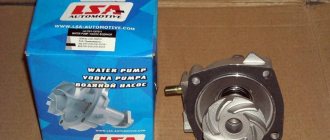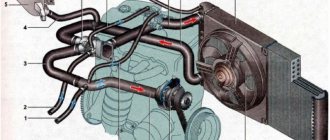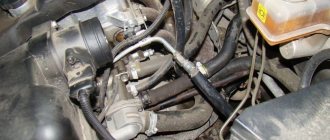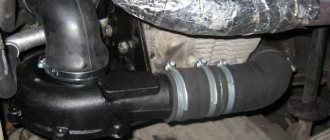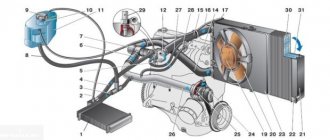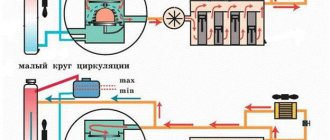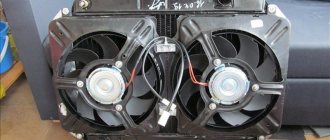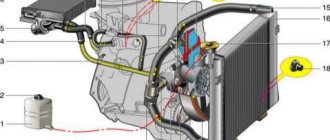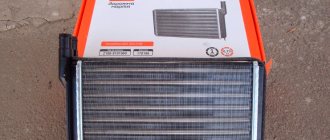While driving, any engine tends to heat up. The VAZ 2106 engine is no exception. During normal operation of all systems, the operating temperature of the engine should be no more than 85 - 90%. You can find out the temperature using a special sensor located on the instrument panel.
To prevent the engine from overheating, a cooling system is provided. It is filled with antifreeze or antifreeze, which circulates inside the cylinder block, cooling it. You can take a closer look at the cooling system in this article.
Purpose
Engine cooling serves to forcibly remove temperature from heated parts. During the working stroke, a temperature of 700 - 800 degrees is created in the cylinder. If it is not forcibly lowered, the rubbing parts may expand greatly, and the crankshaft will jam.
Scheme of work
In addition to the fact that the liquid circulates inside the cylinder block, it is also further cooled when it enters the radiator. Thus, engine operation can be continuous.
How to flush the outside of an engine cooling radiator?
A car radiator mostly consists of tubes in which antifreeze circulates and so-called cooling fins located between them. With the help of a fan or while the machine is moving, air passes through the fins, which cools them. These fins are placed very close together for efficiency, so it is not surprising that they often become clogged with leaves, sand, midges and dirt.
This means that the radiator should be periodically washed not only inside, but also outside. But the problem is that the radiator is a rather fragile element in the car. The metal thickness of the radiator can be as little as 0.15 mm or even less. In practice, the radiator fins can be bent even with your finger. Therefore, strong water pressure can damage the entire radiator.
Therefore, the cleaning procedure must be gentle. Do not wash the cooling radiator with a high pressure washer. It is permissible to water only under low pressure. An alternative is to use compressed air, but you also need to be careful with the pressure. For mechanical cleaning, it is best to use a brush; even a sponge may be too harsh.
Let's start flushing the radiator
In general, flushing the outside of a cooling radiator is a fairly simple operation. Let's look at the whole procedure step by step:
- The first thing you have to do is provide yourself with free access to the front of the radiator. To do this, you often have to remove the grille and radiator fan, and sometimes the bumper.
- Next we act depending on the contamination of the radiator:
- If the cooling element is relatively clean, then you can get by by washing the element with a stream of water. The main thing is not to overdo it with water pressure. And if the jet is powerful enough, then the flow should be directed to the radiator from a long distance and only at a right angle.
- If the radiator is quite clogged, then it is unlikely that it will be possible to thoroughly rinse it without additional cleaning measures. Therefore, we use the method described below.
The second flushing option looks like this:
- First, take a brush and carefully remove the top layer of dirt from the radiator.
- Next, we wash the radiator honeycombs using the method described above.
- After this, apply one of the cleansers. The best product to use is engine cleaning foam or some similar foam composition. A less effective option is to use car shampoo or just a soap solution. We simply apply foam from a can or any other solution and, using a brush, carefully distribute it in the direction of the radiator mounts.
- We wait a few minutes until the product is absorbed into the stubborn dirt, after which we rinse the radiator with a stream of water.
- We evaluate the work done. If the result is unsatisfactory, in order to wash away the remaining contaminants, we repeat the operation again.
- The final step is to assemble the body elements in reverse order.
New articles
- Is it possible to put diesel engine oil into a gasoline engine?
- How to check compression in engine cylinders with your own hands?
Device
The first place where the fluid begins its flow is the radiator. On VAZ 2106 models, two types of radiators were installed - copper and aluminum. The first one is of higher quality, and if cracks appear on its surface, they can easily be welded. In contrast, any crack on an aluminum part is its certain death.
The radiator figuratively consists of three parts: the upper barrel, the cooling honeycomb and the lower barrel. The upper tank has a filler neck for adding coolant. During operation, hot liquid that has gone through one cycle is collected in this tank. Further, it descends into the lower barrel, through the honeycombs, simultaneously being cooled by a fan. And in the lower tank, the liquid is already completely cooled and ready for use.
Radiator design
Tubes are connected to the radiator from above and below: two wide and one narrow. A narrow tube connects the radiator to an expansion barrel, designed to allow excess liquid to enter it during heating and expansion. The upper wide tube connects the part to the thermostat, which, in turn, uses a valve to regulate the flow of coolant. Fluid can flow from the thermostat either back to the engine cylinder block or to the radiator.
For forced circulation, the system includes a pump that pumps antifreeze, creating pressure inside the block. Between the cylinders, a specially made void is provided, where this liquid enters.
Thermostat and cooling system upgrades
Before we begin the modernization, we will study the article about the features of the cooling system of VAZ cars.
In short, the essence of the problem lies in the imperfect operation of the VAZ thermostat and the cooling system; to solve it, we will make minor modifications.
Cooling system upgrade
- Remove the thermostat by first draining the coolant and disconnecting the pipes.
- We swap the expansion tank pipe and the pipe coming out of the VAZ 2110 stove.
Thermostat upgrade
We disassemble the removed thermostat and find the bypass channel, the hole of which is the cause of the lack of heat.
Let us immediately note that this upgrade is only valid for a 5-hole thermostat. Learn in detail how 6 and 5 hole thermostats differ.
Reducing the thermostat bypass channel
- From a piece of thin aluminum we cut a plate exactly in the shape of the lower part of the bypass channel.
- We secure it using self-tapping screws.
- Drill a hole in the plate with a diameter of 6-7 mm
- We assemble and install the thermostat in place.
- We connect all the pipes, not forgetting to swap places between the expansion tank pipe and the pipe coming out of the VAZ heater stove.
Malfunctions
Quite often, on VAZ 2106 cars, the engine cooling system fails and requires repair. The main elements that are most subject to wear are the radiator and thermostat. More rarely, the cause of failure is in the pipes. In order to determine that there is a malfunction in this particular system, it is enough to know its characteristic symptoms. The first thing that immediately becomes noticeable is engine overheating. At the same time, in the area of the legs of the passenger and driver, high temperature and hot air flows will be felt. The cause of this malfunction may be either a failure of the thermostat or radiator, or wear of the pipes.
The difference is that when cracks appear in the pipes, a leak of antifreeze or antifreeze will be visually noticeable. It will ooze out, either from cracks or from joints. When you open the hood, there will be visible places on the engine parts that differ significantly from the basic condition, especially in their shine. This effect is obtained due to the constant exposure of the coolant to the same part of the coating.
If the radiator or thermostat is broken, there may not be any drips, but in this case, the antifreeze simply does not enter the radiator, but constantly circulates in the system, not having time to cool, and as a result, boiling away.
The most common cause of antifreeze leakage from a VAZ 2106 engine is wear of the radiator cap valve. It is not possible to determine its failure immediately. If after each trip the antifreeze level decreases, then carry out the following procedure. Immediately after the engine warms up, open the hood and pull out the choke a centimeter so that the crankshaft speed reaches 2000 - 2500 rpm. Keep a close eye on the lid. If, over time, liquid begins to emerge from under it, then this is clearly the reason.
Coolant replacement
Antifreeze circulating through the cooling circuit of the VAZ 2106 gradually loses its anti-corrosion properties, becomes dirty and forms scale. Therefore, periodic replacement of the fluid is necessary at intervals of 2-3 years, depending on the intensity of use. Which coolant is better to choose:
- initially the manufacturer recommended pouring G11 class antifreeze, colored blue or green (this also includes antifreeze, invented in the USSR);
- it is allowed to fill with liquid of classes G12 and G12+, made on the basis of ethylene glycol, the color is predominantly yellow and orange;
- the best and most modern option is G13 antifreeze based on propylene glycol, color – pink or purple.
To replace antifreeze in the cooling circuit of a VAZ 2106, you need to purchase 10 liters of new fluid and follow the instructions:
- While the engine is cooling, remove the dust shield located under the radiator drain plug. It is fastened with 4 8mm key screws.
- Open the stove tap, place a container under the drain neck of the body exchanger and remove the plug. A small amount of liquid will drain.
Brass radiators may not have a drain outlet. Then you need to unscrew the temperature sensor or remove the large lower hose and drain the antifreeze through the pipe.
To prevent air pockets from forming when filling the circuit with new fluid, you need to remove the hose at the highest point of the system. On carburetor versions this is the manifold heating tube, on injection versions it is the throttle valve.
Fill through the upper neck of the radiator, observing the removed pipe. As soon as antifreeze flows from the hose, immediately put it on the fitting. Then install the heat exchanger plug and add fluid to the expansion tank. Start the engine, warm it up to a temperature of 90 °C and make sure that the radiator housing is warmed up from top to bottom.
Video: how to correctly change the coolant on a VAZ 2106
The VAZ 2106 cooling system does not require much attention from the car owner. The driver will be informed about emerging problems related to engine overheating by the liquid temperature indicator on the instrument panel
During operation, it is important to monitor the level of antifreeze in the expansion tank and the appearance of wet spots under the car, indicating leaks
Repair
If a malfunction is detected in the engine cooling system, it must be repaired immediately. Otherwise, this may have a detrimental effect on the operation of the motor, and even lead to its jamming.
If the cause of the breakdown is the thermostat, then it most likely needs to be replaced. Or, if you have some experience in repairing such parts, you can purchase a repair kit consisting of a new piston, gaskets, and valves. With a radiator, everything is much more complicated. If cracks appear on its surface, the part must be completely dismantled and welding work must be carried out. But, this method only works on a copper sample. If the aluminum radiator becomes unusable, then only replacing it with a new one will help.
The simplest thing that can be changed without problems and losses is the pipes. When they wear out, it is enough to simply install a new part. But, when replacing, be sure to drain the liquid from the system. Also, purchase new mounting clamps, as old ones may not provide proper pressure on the pipes.
Also, a very simple part to replace is the radiator cap. It is very easy to change and is relatively inexpensive. A more serious breakdown occurs when antifreeze leaks from the engine block itself. This indicates the appearance of cracks in the block, and repairing it will be very difficult.
The engine is breathing
The breather is designed to relieve excess pressure from the crankcase, ventilate it and remove gases generated during its operation. If there is a malfunction, smoke begins to pour out of all engine openings. Oil consumption increases sharply.
There can be three reasons for this problem:
- The ventilation system is dirty. Due to the fact that a blockage has formed in the ventilation, the pressure is not released in time. Gradually, gases accumulate and when the pressure reaches a critical value, a sharp release of accumulated gases occurs. The tube that connects the breather to the manifold flies out. As a result, the driver hears a loud bang. Sometimes the gases can rupture the valve cover, break engine parts and even tear out the pan. To correct the situation, you need to flush the ventilation system using a special additive. You can also disassemble the breather yourself and clean the filter using gasoline.
- Occurrence of piston rings. Gases begin to penetrate into the crankcase, from where, due to increased pressure, they find outlets in various cracks. Oil begins to squeeze out through the dipstick or flows into the combustion chamber. The “check” lights up on the dashboard. In this case, you need to check the compression and diagnose the condition of the engine. If at least one “boiler” shows less than 11 points, it is necessary to disassemble the engine and look for damage.
- Damage to cylinder liners. If the two previous possible causes are not confirmed, look for the cause in the cylinder-piston group. If the liners are damaged, you need to grind the cylinders and install new pistons.
Liquid pump
This element of the system allows you to improve the circulation of fluid through the pipes and radiators. Of course, due to the fact that the hot antifreeze moves, displacing the cold one, the system will somehow work. However, it is extremely important to give additional acceleration to ensure two conditions. Firstly, the liquid should not be heated to critical temperatures. Secondly, it must cool as quickly as possible. Short-term heating and cooling allow you to maintain the temperature at a given level.
The liquid pump is a rotor in an aluminum casing, which has an impeller on the inside and a drive pulley on the outside. It is with the help of the impeller that the cooling system of the VAZ-2106 works normally (the flow diagram of the fluid flow is shown in the figure above). The impeller is made of plastic. But there are also aluminum samples, but it is unwise to use them for the reason that they can quickly collapse if water is used rather than antifreeze. The most common pump failure is a bearing failure. It can break gradually if the drive belt is over-tensioned.
Radiator clogged: nuances
The radiator can become clogged with various small debris, everyone knows this. Only regular cleaning can save you from this, especially in the warm season, when there is a lot of dust, insects, and poplar fluff in the air. If the antifreeze is of low quality or you forgot to change it on time, then the blockage is aggravated from the inside.
So, you need to clean the radiator. We wait until the engine cools down. Drain the antifreeze. Already by the drain you can determine how damaged the radiator is from clogging. The antifreeze itself may also be the reason why the VAZ is heating up, and this will be clear from its color. To clean the radiator and its channels from the inside, it is best to fill with water and warm up the engine until the operating temperature of the engine is reached. Then turn off, wait until the engine cools down, and drain the water. Repeat if necessary. If this does not help, then it is better to contact a car service center or replace the radiator with a new one.
Flushing the radiator yourself must be approached with caution.
Overheating of the VAZ 2106 engine can occur when a fan breaks down, a leak in the pump and a subsequent decrease in pressure in the cooling system, when using fuel with a higher octane number than required.
Cleaning the radiator using an automatic manual car wash
Expansion tank
It would seem that one can talk about such a simple and uncomplicated element as an expansion tank. On the one hand, any container that satisfies certain conditions can be used as it. But without this unit the cooling system of the VAZ-2106 will not be able to work normally. The volume of liquid always changes, it is not constant. But there is no more room for it in the pipes, engine jacket and radiator. And the reason that the volume of a liquid changes is the constant fluctuation of its temperature.
When the temperature increases (heating), the distance between the molecules of the substance increases. Everyone knows this from a physics course. Now imagine if the temperature of the antifreeze increased from zero to 80 degrees. Of course, its volume will also become larger. And the excess liquid has to go somewhere. They go through the pipe into the expansion tank. When the temperature drops, the volume steadily decreases. And all the excess that went into the tank is returned to the radiator and pipes.
The amount of antifreeze in VAZ 2106
The technical specifications for any car indicate the volume of coolant that must be poured into the expansion tank for the normal operation of all systems and mechanisms. Let's find out how much antifreeze a VAZ 2106 will need to ensure uninterrupted engine operation.
What is coolant
First of all, you need to decide on the type of cooler, since the VAZ 2106 is filled with antifreeze and antifreeze. For this purpose, let's look at some of the differences and similarities between coolants.
Antifreeze
- this is the development of Soviet scientists and almost every second person is accustomed to calling any cooler this way. It consists mainly of water, ethylene glycol and additives of mineral origin.
This cooler can be mainly used in engines made of heavy metal alloys
, since the property of forming films on the internal parts of the engine and the system as a whole has a detrimental effect on aluminum parts.
Antifreeze almost does not protect against corrosion and it also tends to form sediment, which, when accumulated, clogs narrow hoses.
Antifreeze
- this is already a development of foreign automakers, which with each new type they are trying to improve, make it better and safer for the engine.
Antifreezes exist in the following classes: G11, G12, G12+, G12++, G13.
But, let’s say, the G11 class is similar in composition and quality indicators to the domestic cooler, so you can safely interchange them.
How to replace antifreeze in a VAZ 2106
Before you start replacing the cooler, you need to know how many liters of antifreeze to pour into the VAZ 2106, how best to do this so as not to cause harm, what type of liquid to choose so that it fits your car’s engine as best as possible.
Only after you have clarified all these points can you begin to replace the antifreeze or antifreeze yourself. But, if you are still not confident in the thoroughness of your knowledge, then it is better to contact qualified specialists at a service station.
Procedure for replacing antifreeze
So, having clarified all the necessary points, we found out that in the VAZ 2106 the volume of coolant is about ten liters
, so you need to take exactly ten liters of coolant. Before use, the concentrate must be diluted according to the instructions or purchased ready for use.
Coolant replacement steps:
- Check the sensor, which is responsible for the qualitative and quantitative indicators of antifreeze in the system.
- Drain off any remaining old antifreeze. To do this, you need a container into which the waste material will drain.
- Make sure that the engine has completely cooled down, because if this does not happen, you can easily get a serious burn.
- Place the car on a slope to better drain all unnecessary liquid.
- Unscrew the plugs and bolts from the radiator and expansion tank.
- Be sure to rinse the entire system several times with water or special products. This is primarily necessary when you want to use another type of cooler.
- Fill with new antifreeze and turn on the engine. Let it work for a while.
- Now you can check the sensor readings, temperature and how much antifreeze is in the tank. If the quantity is insufficient, you can add antifreeze to the required level.
- Tighten all the plugs and bolts and the car is ready for further use.
https://www.youtube.com/watch?v=https://www.youtube.com/watch?v=tVZI0WCXRXk
We independently change the thermostat on a VAZ 2106
Before starting work, you should select tools and consumables. To replace the thermostat we will need:
- new thermostat;
- coolant (5 liters);
- basin for draining old antifreeze;
- flat screwdriver.
It should be noted here that the thermostat cannot be repaired. The reason is simple: inside it has a thermoelement with liquid or solid filler. It is the one that fails most often. But such elements are not sold separately, so the car owner has only one option - replacing the entire thermostat.
Sequence of work
Before performing any manipulations with the thermostat, you need to drain the coolant. Without this operation, further work is impossible. It is convenient to drain antifreeze by placing the car on an inspection hole and unscrewing the cap of the main radiator.
- After draining the antifreeze, the car hood opens. The thermostat is located to the right of the engine. Three hoses come to it.
- The hoses are attached to the thermostat pipes using steel clamps, which are loosened using a flat-head screwdriver.
- After loosening the clamps, the hoses are removed from the pipes manually, the old thermostat is removed and replaced with a new one. The hoses are returned to their place, the clamps are tightened, and new coolant is poured into the radiator. The thermostat replacement procedure can be considered complete.
Video: changing the thermostat yourself
So, the owner of a VAZ 2106 does not need to go to the nearest car service center to replace the thermostat. Everything can be done with your own hands. This task is entirely within the capabilities of a novice driver who has at least once held a screwdriver in his hands. The main thing is not to forget to drain the antifreeze before starting work.
Flushing Recommendations
Today in our car stores you can find many different products and liquids for flushing the cooling system. Many car enthusiasts mistakenly believe that the best option is to use distilled water, but this is far from the case. Ordinary liquid contains a large amount of salts, which, as a result of washing, form scale on the internal walls of the system elements.
Special equipment
The range of specialized cleaning products is quite huge - liquids with different compositions and concentrations can be found on sale.
However, you need to pay attention to the choice of cleanser, since different products should be used to remove different types of contaminants. In general, such liquids are divided into several types:
- Neutral products contain no aggressive elements. It is better to use such products for preventive purposes, since they are not very effective for flushing directly.
- The composition of acid additives is very aggressive, so they are not sold in their pure form. Usually used by specialists to remove scale from the cooling system.
- Alkaline products have an aggressive composition and are designed to remove organic formations.
- In the case of two-element products containing alkali and acid, flushing allows you to remove almost all types of contaminants from the cooling system.
Experts do not recommend using several types of liquids at the same time because alkali and acid can be neutralized by each other when interacting. Accordingly, this will not bring the desired result. We also do not recommend using too concentrated products, as this may cause the liquid to corrode the rubber and plastic components of the system.
Traditional methods
Cleaning the cooling system with citric acid is an old flushing method that has been used by domestic motorists for decades. If the proportions are correct, then citric acid will allow you to optimally remove scale from the radiator, without negatively affecting rubber and plastic. According to experienced motorists, you will need about 100 grams of citric acid per 1 liter of distillate. But keep in mind that no one is responsible for the effectiveness of the method, so all responsibility falls on you.
Car enthusiasts also practice using regular cleaning serum instead of citric acid.
According to those who practice this method regularly, the composition of the serum allows for effective and, importantly, gentle flushing of the car’s cooling system. As in the previous case, the serum will not destroy rubber and plastic elements
According to experts, this procedure should be carried out in two or three short approaches - this will allow the system to be flushed most effectively.
"Coca Cola"
There are different opinions among our car enthusiasts about Coca-Cola. One claims that thanks to aggressive components, such as phosphoric acid, included in the drink, Coca-Cola can effectively remove all dirt and scale from the elements of the car’s cooling system. According to others, such an aggressive drink should be used very carefully, or better not used at all, since sugar, which is in excess in the composition, will only contribute to clogging of the pipes. So if you decide to use the drink, then after it in any case you need to use the distillate again to eliminate sugar residues.
Also, the drink can damage the car due to the presence of gas in it. Since gas tends to expand when interacting with the heat of a car engine, this can cause certain problems. So in case you don't have the right products on hand to clean the system, but you have a nosebleed, you need to do it, get rid of the gas in your drink. Open it and leave it with the cap open for an hour. The longer, the more gases will come out of the bottle.
Coca-Cola for rinsing
System radiators
When repairs are performed on a VAZ-2106 car, the cooling system is rarely turned off. The exception is engine removal. In this case, you will need to drain the liquid and disconnect the pipes going to the heater and cooling radiators. What is a radiator? These are two small containers that are located in a horizontal plane. Metal tubes - cells - are laid vertically between them. Hot liquid is fed into the upper container and enters dozens of thin cells, which allows it to cool faster.
Materials for the manufacture of radiators are copper, bronze, brass, plastic. Only the upper and lower containers are made from the latter. To increase the efficiency of heat transfer, there are several hundred very thin plates between the cells. Due to the fact that the area increases, the heat transfer of the radiator also improves. The design of the main radiator and the one located in the stove are the same. But there is a minor feature of the first one - the expansion tank is connected to it. All excess liquid is forced out of the radiator and enters the tank.
How to remove the pump on a VAZ 2106 car
Regardless of the chosen method of troubleshooting, the water pump will have to be removed from the car. The operation cannot be called complicated, but it will take a lot of time, especially for inexperienced drivers. The whole procedure is performed in 4 stages.
- Preparation of tools and work location.
- Disassembly and dismantling of the element.
- Selecting a new spare part or repair kit for an old pump.
- Restoration or replacement of the pump.
After disassembly, the removed pumping unit should be examined for restoration. If only primary symptoms of wear are noticeable - a slight play of the shaft, as well as the absence of damage to the housing and the main bushing - the element can be restored.
Buying and supplying a new spare part is much easier than disassembling and restoring a worn-out pump
Required tools and supplies
You can remove the “six” water pump on any flat surface. The inspection ditch simplifies only one task - unscrewing the generator mounting nut in order to loosen the belt. If desired, the operation is performed lying under the car - it is not difficult to reach the bolt. The exception is cars that have preserved side casings - anthers, screwed on from the bottom with self-tapping screws.
No special pullers or devices are required. The tools you need to prepare are:
- a set of heads with a crank equipped with a ratchet;
- wide container and hose for draining antifreeze;
- a set of ring or open-end wrenches with dimensions of 8-19 mm;
- mounting blade;
- flathead screwdriver;
- knife and brush with metal bristles for cleaning flanges;
- rags;
- protective gloves.
From consumables, it is recommended to prepare antifreeze, high-temperature sealant and aerosol lubricant such as WD-40, which makes it easier to loosen threaded connections. The amount of antifreeze purchased depends on coolant losses due to pump failure. If there is a slight leak, it is enough to purchase a 1 liter bottle.
Taking this opportunity, you can replace the old antifreeze, since the liquid will still have to be drained. Then prepare a full filling volume of antifreeze - 10 liters.
Disassembly procedure
The procedure for dismantling the pump on the “six” is greatly simplified compared to the newer front-wheel drive VAZ models, where you have to remove the timing belt and disassemble half of the drive with markings. On the “classic” the pump is installed separately from the gas distribution mechanism and is located outside the engine.
Before starting disassembly, it is advisable to cool the warm engine so that you do not have to burn yourself with hot antifreeze. Drive the car into the workplace, apply the handbrake and disassemble according to the instructions.
- Lift the hood, find the drain plug on the cylinder block and place a cut canister underneath to drain the antifreeze. The mentioned plug in the form of a bolt is screwed into the left wall of the block (if you look in the direction of travel of the car).
- Partially drain the cooling system by unscrewing the plug with a 13 mm wrench. To prevent antifreeze from splashing in all directions, place the end of a garden hose lowered into the container against the hole. While draining, slowly open the radiator and expansion tank caps.
- When the bulk of the antifreeze has flowed out, feel free to screw the plug back, tightening it with a wrench. There is no need to completely drain the liquid from the system - the pump is located quite high. After this, loosen the lower nut securing the generator.
- Remove the belt drive between the crankshaft, pump and generator. To do this, use a 19 mm wrench to loosen the second nut securing the generator to the adjusting bracket. Using a pry bar, move the unit body to the right and remove the belt.
- Using a 10 mm spanner, unscrew the 3 M6 bolts holding the belt pulley to the pump hub. To prevent the shaft from spinning, insert a screwdriver between the bolt heads. Remove the pulley.
- Separate the belt tension adjusting bracket from the pump body by unscrewing the 17 mm nut on the side.
- Using a 13 mm socket, loosen and tighten the 4 pump mounting nuts. Using a flathead screwdriver, separate the flanges and pull the pump out of the housing.
After removing the pumping unit, perform 3 final steps:
- plug the open opening with a rag and use a knife to clean off the remaining cardboard gasket from the landing pad;
- wipe the block and other components where antifreeze previously splashed;
- remove the pipe at the highest point of the cooling system connected to the intake manifold fitting (on the injector, the heating pipe is connected to the throttle valve block).
The pipe at the highest point is turned off for one purpose - to open the way for air displaced by antifreeze when filling the system. If you ignore this operation, an air lock may form in the pipelines.
